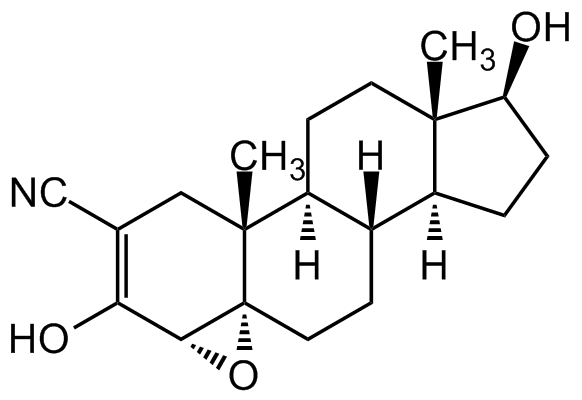
Chemical Structure
Trilostane
CDX-T0449
CAS Number13647-35-3
Product group Chemicals
Estimated Purity>98%
Molecular Weight329.43
Overview
- SupplierChemodex
- Product NameTrilostane
- Delivery Days Customer10
- CAS Number13647-35-3
- CertificationResearch Use Only
- Estimated Purity>98%
- Molecular FormulaC20H27NO3
- Molecular Weight329.43
- Scientific DescriptionChemical. CAS: 13647-35-3. Formula: C20H27NO3. MW: 329.43. Trilostane is an inhibitor of the 3beta-HSDs (3beta-HSD1 and 3beta-HSD2 with Ki values of 0.10 and 1.60 microM, respectively) which plays a role in adrenal steroid biosynthesis. 3beta-hydroxysteroid dehydrogenase (3beta-HSD) type 1 and type 2 isoforms are key enzymes for the biosynthesis of all active steroid hormones. 3beta-HSD1 (type I) is expressed in placenta and peripheral tissues including breast tumors, whereas 3beta-HSD2 (type 2) is expressed in the adrenal gland, ovary and testis. While Trilsotane has been approved for use in the treatment of Cushings syndrome in dogs to reduce cortisol, aldosterone and corticosterone levels, it is being investigated as a possible treatment for both breast cancer and prostate cancer to prevent the synthesis of estrogens and androgens from endogenous precursors. Trilostane has also anti-inflammatory and analgesic properties and systemic administration of trilostane directly affected peripheral and brain levels in neuroactive steroids and monoamine turnover, resulting in antidepressant activity. - Trilostane is an inhibitor of the 3beta-HSDs (3beta-HSD1 and 3beta-HSD2 with Ki values of 0.10 and 1.60 microM, respectively) which plays a role in adrenal steroid biosynthesis. 3beta-hydroxysteroid dehydrogenase (3beta-HSD) type 1 and type 2 isoforms are key enzymes for the biosynthesis of all active steroid hormones. 3beta-HSD1 (type I) is expressed in placenta and peripheral tissues including breast tumors, whereas 3beta-HSD2 (type 2) is expressed in the adrenal gland, ovary and testis. While Trilsotane has been approved for use in the treatment of Cushings syndrome in dogs to reduce cortisol, aldosterone and corticosterone levels, it is being investigated as a possible treatment for both breast cancer and prostate cancer to prevent the synthesis of estrogens and androgens from endogenous precursors. Trilostane has also anti-inflammatory and analgesic properties and systemic administration of trilostane directly affected peripheral and brain levels in neuroactive steroids and monoamine turnover, resulting in antidepressant activity.
- SMILESOC1=C(C#N)C[C@@]2(C)[C@@]3(CC[C@]4([H])[C@]2([H])CC[C@@]5(C)[C@@]4([H])CC[C@@H]5O)[C@@H]1O3
- Storage Instruction2°C to 8°C,RT
- UNSPSC12352200

![Trilostane [13647-35-3]](https://www.targetmol.com/group3/M00/02/23/CgoaEGY7KfSEFJBuAAAAANOsSyI754.png)
